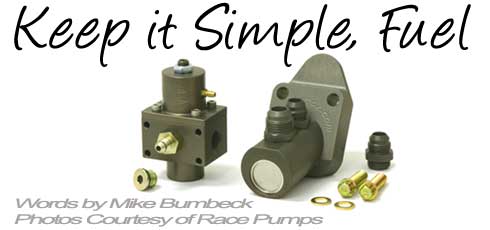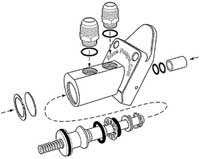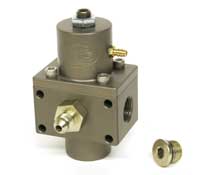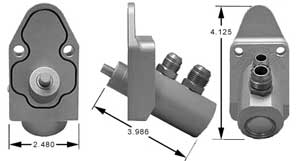 |
||||||||||||
3/8/06
Making systems more complex often results in even more complex systems to keep track of the ever-increasing complexity of the system. And so on. The snowball effect applies here. If something works, don't fix it, but if something doesn't work, making it more complicated doesn't always lead down the path to being better. In the case of fuel systems things can get out of hand quickly. As displacement grows, and induction demands more fuel, this creates greater demands on the fuel supply system. The old style engine-driven diaphragm pumps will only cut it up to a certain point. The next stage in fuel delivery are electrically driven rotary vane-style pumps, which of course require use of a regulator. Using a dead head style regulator in conjunction with a vane-style pump can create fuel heating issues. The fuel stacks up in the pump and plumbing against the regulator, and gets warmed by the pump at times of low demand – reducing its efficiency. Add the complexity of a bypass regulator, a return line to the fuel tank, and other associated plumbing and wiring to solve the fuel heating problem and one begins to see how fuel supply systems can quickly get complicated. CALM UNDER PRESSURE While engine-driven diaphragm style pumps were fine for a Hupmobile or Model T, they fall on their face when called upon to deliver the volume and pressure demanded by racing engines, EFI, or alcohol huffing setups. There are worlds of fuel supply solutions out there, but it seems no one ever thought to improve on the engine driven design instead of reinventing the wheel entirely. Until now. Howard Stewart of Stewart Development had an idea for a better mouse trap, or rat trap if you like big blocks. Stewart took the simplicity of the engine-driven fuel pump design and updated it with some ingeniously uncomplicated engineering and modern materials to create the Race Pump for small and big block Chevrolet engines. The simple and lightweight design delivers performance thanks to a reciprocating piston and variable displacement design.
The cornerstone of the design is the variable displacement feature, which adjusts the amount of fuel needed based on engine demand, and acts like a bypass regulator during periods of low demand. No more hot fuel stacking up against the dead head. The reciprocating setup uses far less engine power to deliver fuel, a mere 25 lbs of force compared to 125 lbs for a race version diaphragm-style pump. Best of all, the pump requires only an inlet and an outlet to deliver fuel – even with use on EFI engines. No return line or tank modifications are required on an EFI conversion when using a Race Pump. An unregulated constant 60psi at 204 GPH for the standard pump and 150psi at 204 GPH for the EFI pump is available from 1 to 10,000 RPM. Plumb in one of Race Pump's modular regulators for naturally aspirated, alcohol, EFI or boosted applications and you're simply good to go. SOURCE: Race Pumps
|



